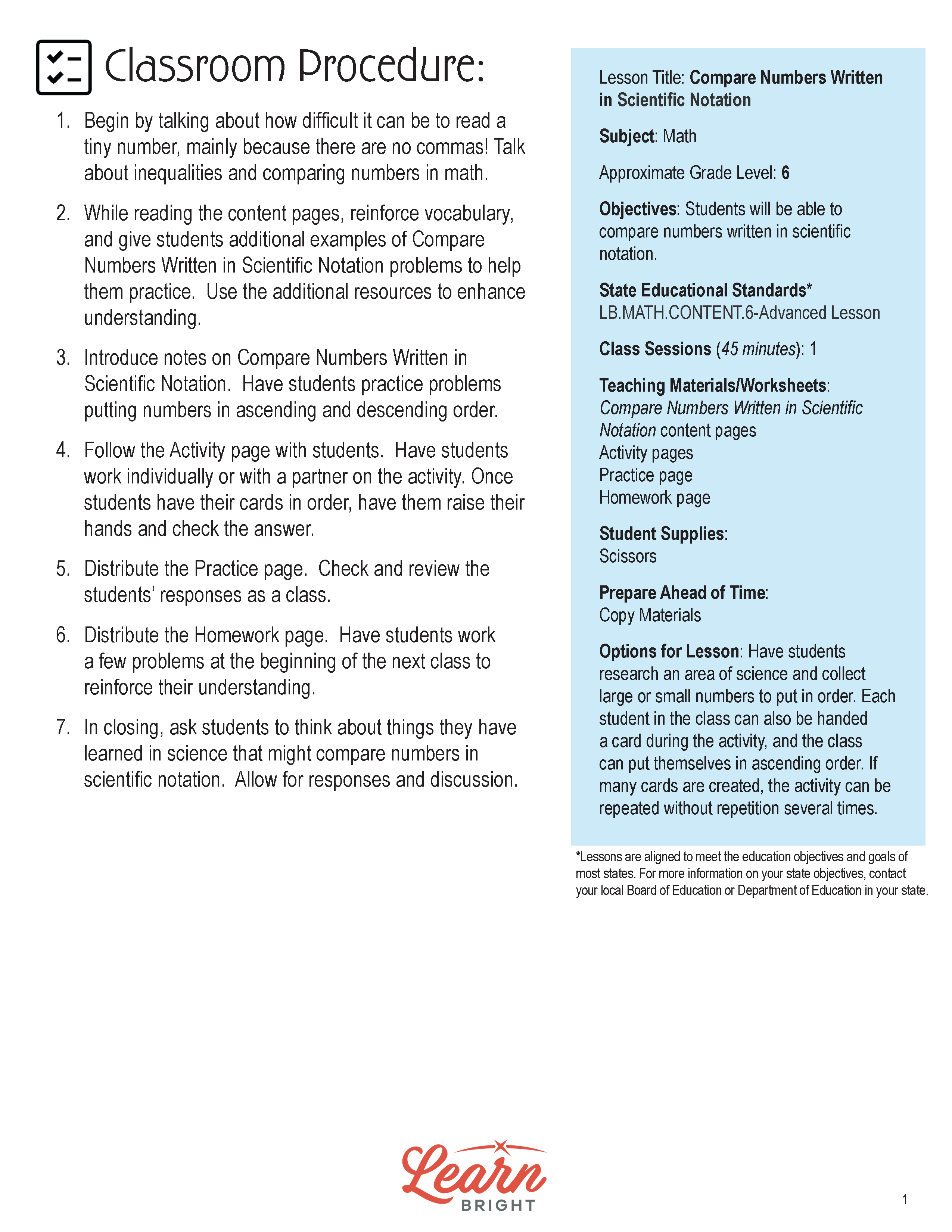Description
What our Compare Numbers Written in Scientific Notation: Advanced lesson plan includes
Lesson Objectives and Overview: Compare Numbers Written in Scientific Notation: Advanced teaches students to build on their knowledge of scientific notation by learning how to compare numbers. At the end of the lesson, students will be able to compare numbers written in scientific notation. This lesson is for students in 6th grade.
Classroom Procedure
Every lesson plan provides you with a classroom procedure page that outlines a step-by-step guide to follow. You do not have to follow the guide exactly. The guide helps you organize the lesson and details when to hand out worksheets. It also lists information in the blue box that you might find useful. You will find the lesson objectives, state standards, and number of class sessions the lesson should take to complete in this area. In addition, it describes the supplies you will need as well as what and how you need to prepare beforehand.
Options for Lesson
Included with this lesson is an “Options for Lesson” section that lists a number of suggestions for activities to add to the lesson or substitutions for the ones already in the lesson. One optional addition to this lesson is to have your students research an area of science and collect large or small numbers to put in order. To adjust the lesson activity, you can hand a card to each student during the activity and have the class put themselves in ascending order; if you create many cards, the activity can be repeated without repetition several times.
Teacher Notes
The teacher notes page includes a paragraph with additional guidelines and things to think about as you begin to plan your lesson. This page also includes lines that you can use to add your own notes as you’re preparing for this lesson.
COMPARE NUMBERS WRITTEN IN SCIENTIFIC NOTATION: ADVANCED LESSON PLAN CONTENT PAGES
Compare Numbers Written in Scientific Notation
The Compare Numbers Written in Scientific Notation: Advanced lesson plan includes three content pages. We use scientific to write very large and very small numbers in a way that’s easy to understand. We call it scientific notation because scientists use it very often in their work because they often use very large or small numbers.
To write scientific notation, we use a specific format: a x 10ᵇ where 1 ≤ |a| < 10. In this equation, b is an integer and a is a real number greater than or equal to one and less than ten. We refer to the coefficient as the significand.
When comparing numbers, we have three possible outcomes: greater than (>), less than (<), or equal to (=). We use these symbols when comparing numbers written in scientific notation as well, using the same symbols. However, when comparing numbers in scientific notation, we first need to make sure that they’re written correctly. Next, we look at the exponent. Finally, we compare the coefficient.
The lesson includes a few examples that show how to compare numbers written in scientific notation. In the first example, we need to compare 4.7 x 10⁵ to 4.3 x 10⁸. First, we check that they’re written correctly, which they are. Next, we compare the exponents. The larger exponent is always the greater number. If the exponents are equal, then we compare the coefficients. In this example, the exponents are 5 and 8. 8 is larger, so we know that 4.3 x 10⁸ is the greater number! We don’t need to compare the coefficients. Instead, we can skip to the last step, writing the correct symbol in between the numbers: 4.7 x 10⁵ < 4.3 x 10⁸.
The lesson ends with two more helpful example problems, which demonstrate a few different scenarios you can run into while comparing numbers written in scientific notation.
COMPARE NUMBERS WRITTEN IN SCIENTIFIC NOTATION: ADVANCED LESSON PLAN WORKSHEETS
The Compare Numbers Written in Scientific Notation: Advanced lesson plan includes three worksheets: an activity worksheet, a practice worksheet, and a homework assignment. You can refer to the guide on the classroom procedure page to determine when to hand out each worksheet.
ASCENDING ORDER ACTIVITY WORKSHEET
For the activity worksheet, students will cut out cards with scientific notations on them and place them in ascending order.
PLANETS PRACTICE WORKSHEET
The practice worksheet asks students to complete two short exercises. For the first, they will write the approximate diameter of each planet in miles using scientific notation. For the second, they will list the planets in order from largest to smallest using scientific notation.
COMPARE NUMBERS WRITTEN IN SCIENTIFIC NOTATION: ADVANCED HOMEWORK ASSIGNMENT
Like the practice worksheet, the homework assignment asks students to complete two short exercises. For the first, they will write the approximate distance of each planet from the sun in miles using scientific notation. For the second, they will list the planets by distance from the sun, going from least to greatest, using scientific notation.
Worksheet Answer Keys
This lesson plan includes answer keys for the activity worksheet, the practice worksheet, and the homework assignment. If you choose to administer the lesson pages to your students via PDF, you will need to save a new file that omits these pages. Otherwise, you can simply print out the applicable pages and keep these as reference for yourself when grading assignments.









